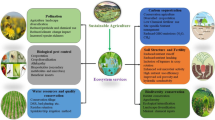Abstract
The methodology is suggested for analyzing the variability and heredity in super-organism genetic systems of different complexity ranging from two-component plant-microbe and animal-microbe symbiosis to the endosymbiotic and soil microbe communities. The approaches based on symbiogenetics and metagenomics may be used for development of highly productive ecologically sustainable agrocenoses based on the substitution of agrochemicals (mineral fertilizers, pesticides) by microbe preparations. A possibility to use the natural analogs of agrocenoses for creation of the models that allowed performing the directed construction and improvement of productivity in the sustainable agricultural systems is emphasized.
Similar content being viewed by others
References
Andronov, E.E., Petrova, S.N, Chizhevskaya, E.P., Korostik, E.V., Akhtemova, G.A., and Pinaev, A.G., Influence of Introducing the Genetically Modified Strain Sinorhizobium meliloti ACH-5 on the Structure of the Soil Microbial Community, Microbiology, 2009, vol. 78, no. 4, pp. 474–482.
Dillon, R.J. and Dillon, V.M., The Gut Bacteria of Insects: Non-Pathogenic Interactions, Ann. Rev. Entomol., 2004, vol. 49, pp. 71–92.
Higa, T. and Parr, J.F., Beneficial and Effective Microorganisms for a Sustainable Agriculture and Environment, International Nature Farming Research Center, Atami, Japan, 1994, pp. 1–16.
Lederberg, J. and McCray, A.T., “Ome Sweet” Omics-A Genealogical Treasury of Words, Scientist, 2001, vol. 15, p. 8.
Margulis, L., Rol’ simbioza v evolyutsii kletki (The Role of Symbiosis in Evolution of the Cell), Moscow: Mir, 1983.
Mueller, U.G., Poulin, J., and Adams, R.M.M., Symbiont Choice in a Fungus-Growing and (Attini, Formicidae), Behav. Ecol., 2004, vol. 15, no. 2, pp. 357–364.
Noda, S., Ohkuma, M., and Kudo, T., Nitrogen Fixation Genes Expressed in the Symbiotic Microbial Community in the Gut Termite Coptotermis formosanus, Microb. Environ., 2002, vol. 17, no. 3, pp. 139–143.
Parniske, M., Arbuscular Mycorrhiza: The Mother of Plant Root Endosymbioses, Nature Rev. Microbiol., 2008, vol. 6, pp. 763–775.
Provorov, N.A., Relationship between Symbiotic and Combined Nitrogen Assimilation in Leguminous Plants: Genetic and Breeding Aspects, Russ. J. Plant Physiol., 1996, vol. 43, no. 1, pp. 111–118.
Provorov, N.A. and Tikhonovich, I.A., Ecological-Genetic Principles of Plant Breeding for Increasing the Efficiency of Interaction with Microorganisms, S.-kh. Biol., 2003, no. 3, pp. 11–25.
Provorov, N.A., Plant-Microbe Symbioses as an Evolutionary Continuum, Zh. Obshch. Biol., 2009, vol. 70, no. 1, pp. 10–34.
Sanchez, L., Weidmann, S., Arnould, C., Bernard, A.R., Gianinazzi, S., and Gianinazzi-Pearson, V., Pseudomonas fluorescens and Glomus mosseae Trigger DMI3-Dependent Activation of Genes Related to a Signal Transduction Pathway in Roots of Medicago truncatula, Plant Physiol., 2005, vol. 139, pp. 1065–1077.
Sessitsch, A., Howieson, J.G., Perret, X., Antoun, H., and Martinez-Romero, E., Advances in Rhizobium Research, Crit. Rev. Plant Sci., 2002, vol. 21, pp. 323–378.
Shevelev, N.S., Grushkin, A.G., and Tarakanov, B.V., Physio-logical Role of Microbiota in Paunch Digestion, S.-Kh. Biol., 2005, no. 6, pp. 9–13.
Tikhonovich, I.A. and Provorov, N.A., Symbiotic Genetics of Microbe-Plant Interactions, Ekol. Genet., 2003, vol. 1, no. 0, pp. 36–46.
Tikhonovich, I.A. and Provorov, N.A., Cooperation of Plants and Microorganisms: New Approaches to Constructing Environmentally Stable Agrosystems, Usp. Sovrem. Biol., 2007, vol. 127, no. 4, pp. 339–357.
Tikhonovich, I.A. and Provorov, N.A., Simbiozy rastenii i mikroorganizmov: molekulyarnaya genetika agrosistem budushchego (Symbioses of Plants and Microorganisms: Molecular Genetics of Agrosystems of the Future), St. Petersburg: Izd. SPbGU, 2009.
Vavilov, N.I., Breeding as a Science, in Vavilov N.I. Teoreticheskie osnovy selektsii (Vavilov N.I. Theoretical Basis of Breeding), Moscow: Nauka, 1987, pp. 28–39.
Author information
Authors and Affiliations
Corresponding author
Additional information
Original Russian Text © I.A. Tikhonovich, N.A. Provorov, 2011, published in Ekologicheskaya Genetika, 2011, Vol. 9, No. 3, pp. 23–26.
Rights and permissions
About this article
Cite this article
Tikhonovich, I.A., Provorov, N.A. The molecular basis for construction of highly productive ecologically sustainable agrocenoses. Russ J Genet Appl Res 2, 353–356 (2012). https://doi.org/10.1134/S2079059712050073
Published:
Issue Date:
DOI: https://doi.org/10.1134/S2079059712050073




